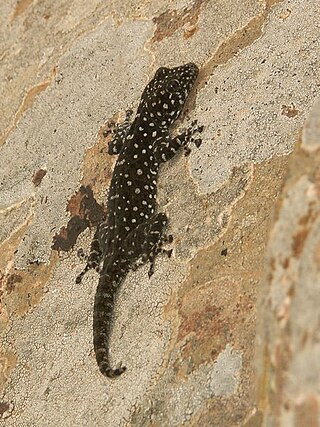
Ptyodactylus is a genus of geckos, which are commonly known as fan-fingered geckos. The genus has 12 described species.

Thecadactylus is a gekko genus from the tropical Americas. They are known as the turnip-tailed geckos. The genus belongs to the gecko family Phyllodactylidae. Until 2007, it was believed to be monotypic, with T. rapicauda the sole species. Then however, the population from upstream southern Amazon basin was discovered to be very distinct and was named a new species, T. solimoensis. A third species was described in 2011.

Rhamphorhynchus is a genus of long-tailed pterosaurs in the Jurassic period. Less specialized than contemporary, short-tailed pterodactyloid pterosaurs such as Pterodactylus, it had a long tail, stiffened with ligaments, which ended in a characteristic soft-tissue tail vane. The mouth of Rhamphorhynchus housed needle-like teeth, which were angled forward, with a curved, sharp, beak-like tip lacking teeth, indicating a diet mainly of fish; indeed, fish and cephalopod remains are frequently found in Rhamphorhynchus abdominal contents, as well as in their coprolites.

Phascolarctos is a genus of marsupials with one extant species, the koala Phascolarctos cinereus, an iconic animal of Australia. Several extinct species of the genus are known from fossil material, these were also large tree dwellers that browsed on Eucalyptus leaves.

The feathered thorn is a moth of the family Geometridae. It was first described by Carl Linnaeus in 1761.

Scaphognathus was a pterosaur that lived around Germany during the Late Jurassic. It had a wingspan of 0.9 m (3 ft).
The Laos warty newt is a species of salamander in the family Salamandridae. It is found only in the Saysomboun Special Zone and Phou Kout District in Xiangkhouang Province, Laos. Its natural habitats are subtropical or tropical dry shrubland and rivers. In 2014, it is classed as Endangered.

Archegosaurus is a genus of temnospondyl amphibian which lived during the Asselian to Wuchiapingian stages of the Permian, around 299-253 million years ago. The remains of this animal, consisting of at least 90 partial skeletons, have been found in Germany. The name Archegosaurus was coined by Goldfuss in 1847. Archegosaurus is a member of Archegosauridae and is that family's type genus.

Sclerocephalus is an extinct genus of temnospondyl amphibian from the lowermost Permian of Germany and Czech Republic with four valid species, including the type species S. haeuseri. It is one of the most completely preserved and most abundant Palaeozoic tetrapods. Sclerocephalus was once thought to be closely related to eryopoid temnospondyls, but it is now thought to be more closely related to archegosauroids. It is the only genus in the family Sclerocephalidae.

Isis is a genus of coral in the family Isididae.

Pleurotomaria is an extinct genus of sea snails, marine gastropod molluscs in the family Pleurotomariidae.
The Fuding fire belly newt is a rare species of newt in the family Salamandridae, endemic to China. It is only known from Fuding in northeastern Fujian, from the locality where it was described as a new species in 2010. Although it is genetically similar to the Chinese fire belly newt, it is morphologically more similar to the Dayang fire belly newt. The range of C. fudingensis is separate from both other species.
Kashmirosaurus is an extinct genus of temnospondyl amphibian known from Permo-Carboniferous deposits in the region of Kashmir. It was originally named by English paleontologist Arthur Smith Woodward in 1905 as a species of Archegosaurus called Archegosaurus ornatus. More recently, the species has been recognized as being distinct from Archegosaurus, and it was placed in its own genus Kashmirosaurus in 1996. An additional species of Archegosaurus, A. kashmiriensis, was named in 1960 from the same deposits in Kashmir, and is now considered synonymous with Kashmirosaurus ornatus.

Plagiostoma is a genus of fossil saltwater clams, marine bivalve mollusks in the family Limidae, the file clams.

Pennaria disticha, also known as the Christmas tree hydroid, is a species of athecate hydroid in the family Pennariidae. Colonies are common in the Mediterranean Sea growing on rocks close to the surface. This species has been used in research into prey capture.
Barboza's leaf-toed gecko is a species of lizard in the family Gekkonidae. The species is endemic to Angola.

Pentacta is a genus of echinoderms belonging to the family Cucumariidae.
The golden shovel-nosed salamander is a species of salamander in the family Plethodontidae. It is endemic to the United States.
The black shovel-nosed salamander is a species of salamander in the family Plethodontidae. It is endemic to the United States.

Madurai rock gecko is a rock-dwelling gecko described in 2023 from Nagamalai near Madurai. It belongs to the same genus as house geckos and has distinct characteristics. Members of this genus are usually non-venomous and are harmless to humans. These geckos are nocturnal and prefer rocky areas.















